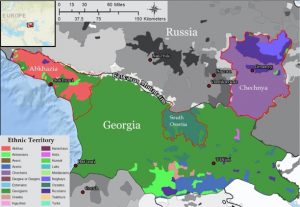90 Russian Domain: Political Geography – Ethnoterritorialism in Georgia
 The country Georgia, definitely not to be confused or conflated with the American state of Georgia, is part of this textbook’s region called the Russian Domain. Georgia also is part of the Caucasus regions, a mountainous area that includes Georgia, Armenia, Azerbaijan, and a bit of Russia. The internal governance of Georgia offers insightful examples of national self-determination and the post-Soviet implications of Soviet ethnoterritorialism.
The country Georgia, definitely not to be confused or conflated with the American state of Georgia, is part of this textbook’s region called the Russian Domain. Georgia also is part of the Caucasus regions, a mountainous area that includes Georgia, Armenia, Azerbaijan, and a bit of Russia. The internal governance of Georgia offers insightful examples of national self-determination and the post-Soviet implications of Soviet ethnoterritorialism.

Photo by Stephen Bache.
As a little bit of historical framework, the pattern for Georgia was one of frequent struggle. Certainly, this can be said of many, many parts of the world, but perhaps the region of Georgia has been particularly suited for strife. A portion of what now is Georgia adopted Christianity as its official religion in the early 4th century, becoming one of the first in the world to do so. However, its neighbors historically included Muslim populations often of some magnitude. Historically, the Islamic Ottoman Empire ruled westward of Georgia. To the south the Persian Empire also featured Islam. Modern day Islamic countries Turkey, Iran, and Azerbaijan lie to the west, south, and east respectively.
Georgia’s location in the Caucasus Mountains offered land routes between Persia and Russia and on to Europe, as well as between Turkey and Russia. Trade and conquest sought these passages. The modern sense of the country Georgia came as a kingdom in the 11th to 13th centuries under the rule of King David IV and Queen Tamar the Great, but both before and after those years, it struggled with invaders and empires.
Bridge of Peace in Tbilisi, Georgia. Video by mostafa meraji from Pixabay.
Direct Link to Video (New Tab)
Russian imperial interest in Georgia was viewed more favorably than that from the Ottoman or Persian empires. Russians were fellow Orthodox Christians, though the Georgian Orthodox Christian Church does stand alone; however, this fellowship was better than the Islamic pressures of the Ottomans and Persians. A late 18th century alliance devolved into an early 19th century annexation of Georgia by Russia. When the Russian Revolution of 1917 ended the Romanov dynasty there, Georgia found an opportunity for independence, taking that step in 1918. The Russian Civil War brought victory by the communist Bolshevik Party and secured recovery of Georgia back into the Russian fold. Georgia remained part of the Soviet Union, as a republic beginning in 1936, until the breakup of the USSR in 1991.
Like all of the republics of the Soviet Union, Georgia was a region (like an American state) based on ethnicity. This was the Georgian ethnic homeland and Georgians surpassed the one-million-person threshold to become a republic. However, at the same time, Georgian territory included other land that was the ethnic homeland of smaller nationalities. In the northwest corner of Georgia, there was the region of Abkhazia. Abkhazia (or Apsny to the natives) was the next ethnoterritorial level down – an Autonomous Soviet Socialist Republic or ASSR. Nevertheless, the majority ethnic group in Abkhazia was Georgian (roughly 50%), not Abkhaz (about 20%).

Upon the breakup of the Soviet Union, Abkhazia sought to become an independent country. While all the republics of the USSR became independent countries, the ASSR regions in Russia were upgraded to the republic level in the new Russia. Chechnya, one of these smaller ethnic regions, sought what could be termed a double upgrade to country. Russia denied this request, twice smashing Chechnya in brief civil wars. In Georgia, the Abkhaz minority population of this ethnic region also sought the double upgrade. Naturally, Georgia opposed this move; however, Georgian forces fared poorly in a civil war in 1992-1993. Abkhazia gained de facto independence, while Georgia meekly maintained a claim to the territory. In the aftermath, several thousand Georgian were killed in Abkhazia, while a quarter million Georgians were expelled from their homes and from Abkhazia. In over two decades following, Russian military and political support increased, so that in 2008 Georgia declared Abkhazia to be a “Russian-occupied territory.” Abkhazia considers itself an independent country, but it recognized by very few recognized countries, though it is endorsed by Artsakh, Transnistria, and South Ossetia, which are similar post-Soviet territories of limited recognition.
South Ossetia also is an ethnic territory within Georgia. Of rather modest population, South Ossetia ranked lower as the South Ossetian Autonomous Oblast’ (AO). Also of note is the existence of North Ossetia directly across the border in Russia. Logically, by national self-determination North and South Ossetia should be one region; instead, Soviet machinations with borders and ethnic groups found advantage in splitting this little region in two.
Like Abkhazia, South Ossetia formerly had a higher number of Georgians living there, not so much anymore. In 1989 as the Soviet Union neared its end, Georgians held 29% of South Ossetia’s nearly one hundred thousand residents, while Ossetians were 66%. By 2015, the numbers had altered to Georgians 7%, Ossetians 90%. Again, as with Abkhazia, this change resulted from military conflict and Russian assistance. Violence broke out in 1991-1992 between South Ossetian and Georgian forces, but to no resolution.

In August 2008 skirmishes commenced between the sides, but in the case the stakes were heightened when Russian forces attacked Georgia. As it was in Abkhazia, here too thousands of Georgians were displaced. Although a ceasefire was established and Russian military backed off, South Ossetia asserted its sovereignty and independence, seeking what could be called a triple upgrade from its former status as an AO within Georgia. Russia recognized South Ossetia and Abkhazia as independent countries. Of course, the quasi-states of Artsakh, Transnistria, and Abkhazia also recognized South Ossetia’s claim.

Both these regional cases in Georgia are in part the result of Soviet ethnoterritorialism, the pattern of creating a hierarchy of governmental regions sometimes based on the ethnic peoples living there. (Other regions such as the krai were simply administrative regions.) Given the opportunities following the dissolution of the Soviet Union, it is understandable that some of these ethnic regions stretched the limits in seeking national independence. While this plan failed for Chechnya inside Russia, it has created autonomy at the least for Abkhazia and South Ossetia.
Did You Know?
Stalin was ethnically Georgian. Born Josef Vissarionovich Dzhugashvili, he changed his surname to Stalin, reflecting the power in the Russian word for steel being сталь or stal. Thus, Stalin is the man of steel.
To be a Soviet republic and not a lesser region, there must have been 1) at least one million people in the ethnic group, 2) living on the ethnic homeland, and 3) a region that had an international border. Fifteen regional ethnic groups met these qualifications with Russians and the Russian Federated Soviet Socialist Republic being the largest by far.
Cited and additional bibliography:
Bache, Stephen. 2019. Ananuri Castle, Georgia.
McGinty, James. 2020. “Ethnic Groups in the Caucasus.” College of DuPage. College of DuPage GIS class. Instructor Joseph Adduci.
“Население Южной Осетии.” n.d. Www.Ethno-Kavkaz.Narod.Ru. Accessed June 11, 2020. http://www.ethno-kavkaz.narod.ru/rnsossetia.html.
Plusher, Alexander. n.d. Georgia-Ossetia. Accessed June 10, 2020. https://tinyurl.com/georgiagrief. Attribution 2.0 Generic (CC BY 2.0).

